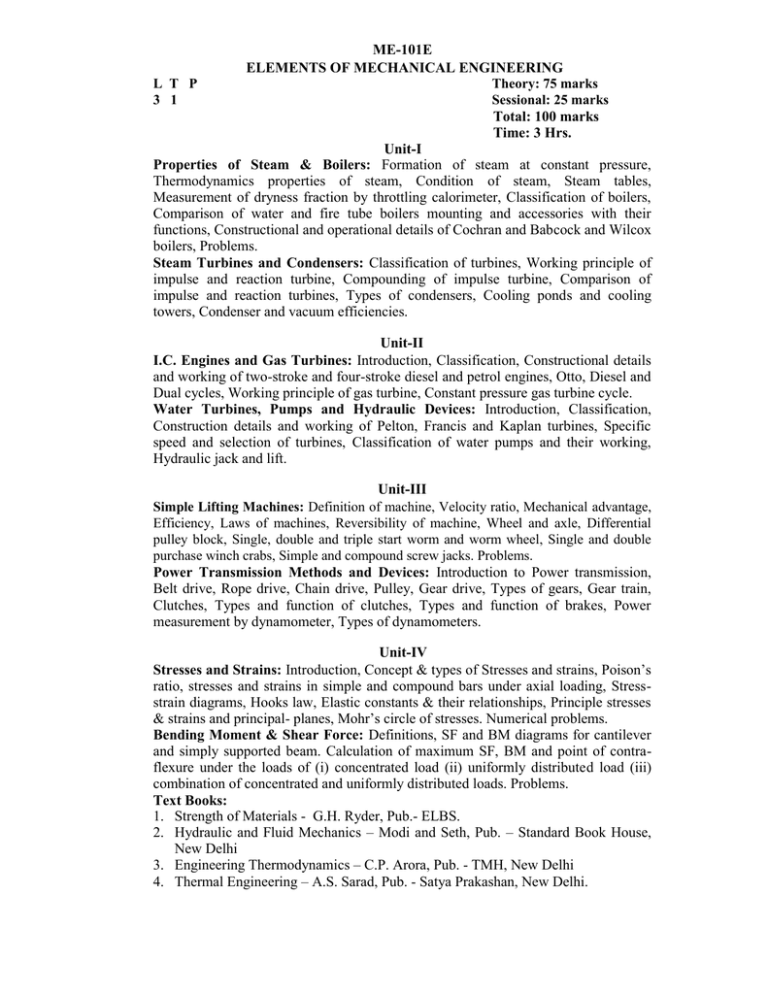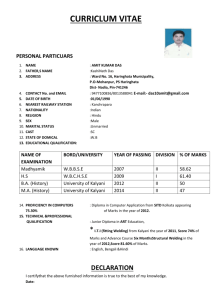ME-101E ELEMENTS OF MECHANICAL ENGINEERING L T P
advertisement

ME-101E ELEMENTS OF MECHANICAL ENGINEERING L T P Theory: 75 marks 3 1 Sessional: 25 marks Total: 100 marks Time: 3 Hrs. Unit-I Properties of Steam & Boilers: Formation of steam at constant pressure, Thermodynamics properties of steam, Condition of steam, Steam tables, Measurement of dryness fraction by throttling calorimeter, Classification of boilers, Comparison of water and fire tube boilers mounting and accessories with their functions, Constructional and operational details of Cochran and Babcock and Wilcox boilers, Problems. Steam Turbines and Condensers: Classification of turbines, Working principle of impulse and reaction turbine, Compounding of impulse turbine, Comparison of impulse and reaction turbines, Types of condensers, Cooling ponds and cooling towers, Condenser and vacuum efficiencies. Unit-II I.C. Engines and Gas Turbines: Introduction, Classification, Constructional details and working of two-stroke and four-stroke diesel and petrol engines, Otto, Diesel and Dual cycles, Working principle of gas turbine, Constant pressure gas turbine cycle. Water Turbines, Pumps and Hydraulic Devices: Introduction, Classification, Construction details and working of Pelton, Francis and Kaplan turbines, Specific speed and selection of turbines, Classification of water pumps and their working, Hydraulic jack and lift. Unit-III Simple Lifting Machines: Definition of machine, Velocity ratio, Mechanical advantage, Efficiency, Laws of machines, Reversibility of machine, Wheel and axle, Differential pulley block, Single, double and triple start worm and worm wheel, Single and double purchase winch crabs, Simple and compound screw jacks. Problems. Power Transmission Methods and Devices: Introduction to Power transmission, Belt drive, Rope drive, Chain drive, Pulley, Gear drive, Types of gears, Gear train, Clutches, Types and function of clutches, Types and function of brakes, Power measurement by dynamometer, Types of dynamometers. Unit-IV Stresses and Strains: Introduction, Concept & types of Stresses and strains, Poison’s ratio, stresses and strains in simple and compound bars under axial loading, Stressstrain diagrams, Hooks law, Elastic constants & their relationships, Principle stresses & strains and principal- planes, Mohr’s circle of stresses. Numerical problems. Bending Moment & Shear Force: Definitions, SF and BM diagrams for cantilever and simply supported beam. Calculation of maximum SF, BM and point of contraflexure under the loads of (i) concentrated load (ii) uniformly distributed load (iii) combination of concentrated and uniformly distributed loads. Problems. Text Books: 1. Strength of Materials - G.H. Ryder, Pub.- ELBS. 2. Hydraulic and Fluid Mechanics – Modi and Seth, Pub. – Standard Book House, New Delhi 3. Engineering Thermodynamics – C.P. Arora, Pub. - TMH, New Delhi 4. Thermal Engineering – A.S. Sarad, Pub. - Satya Prakashan, New Delhi. 9 5. Engineering Mechanics – K.L. Kumar, Pub. - TMH, New Delhi. 6. Theory of Machines – S.S. Rattan, Pub. – TMH, New Delhi. Reference Books: 1. Strength of Materials – Popov, Pub. - PHI, New Delhi. 2. Hydraulic Machines – Jagdish Lal, Pub.- Metropolitan, Allahbad. 3. Thermal Science and Engineering – D.S. Kumar, Pub. – Kateria & Sons, New Delhi. Note: The Examiners will set eight questions, taking two from each unit. The students are required to attempt five questions in all selecting at least one from each unit. All questions will carry equal marks. ME-105E ENGINEERING GRAPHICS AND DRAWING L T P - 3 Examination : 100 marks Sessional: 50 marks Total: 150 marks Time: 3 Hrs. Unit-I Various types of projections, First and Third angle systems of orthographic projections. Projections of points in different quadrants. Projections of straight lines – parallel to one or both reference planes, contained by one or both planes, perpendicular to one of the planes, inclined to one plane but parallel to the other plane, inclined to both the planes, true length of a line and its inclinations with reference planes, traces of a line. Unit-II Projections of Polyhedra Solids and solids of Revolution – in simple positions with axis perpendicular to a plane, with axis parallel to both planes, with axis parallel to one plane and inclined to the other. Development of surface of various simple solids such as cubes, cylinders, prisms, pyramids etc. orthographic views, orthographic drawings of Bolts, Nuts, Bolted joints, screw threads, screwed joints. Note : Some simple exercise may be attempted with AUTOCAD. Text Book 1. Engineering Drawing Plane and Solid Geometry : N.D. Bhatt and V.M.Panchal, Forty-Fourth Edition 2002, Charotar Publishing House. Reference Books 1. Engineering Graphics and Drafting : P.S. Gill, Millennium Edition, S.K. Kataria and Sons. 2. A Text Book of Engineering Drawing : S.B. Mathur, Second Revised and Enlarged Edition 2000, Vikas Publishing House. 3. Engineering Graphics using AUTOCAD 2000 : T. Jeyapoovan, First Edition 2002, Vikas Publishing House. 13 ME- 103E MANUFACTURING PROCESSES L T P Theory : 100 marks 4 Sessional : 50 marks Total: 150 marks Time: 3 Hrs. Unit-I Introduction: Introduction to Manufacturing Processes and their Classification. Industrial Safety; Introduction, Types of Accidents, Causes and Common Sources of Accidents, Methods of Safety, First Aid. Engineering Materials: General Properties and Applications of Engineering Materials, Mild Steel, Medium Carbon Steel, High Carbon Steel, High Speed Steel and Cast Iron. Unit-II Foundry: Introduction to Casting Processes, Basic Steps in Casting Process, Pattern, Types of Patterns, Pattern Allowances, Risers, Runners, Gates, Moulding Sand and its composition, Sand Preparation, Molding Methods, Core Sands and Core Making, Core Assembly, Mold Assembly, Melting ( Cupola) and Pouring, Fettling, Casting Defects and Remedies. Unit-III Cold Working ( Sheet Metal Work ): Sheet Metal Operations, Measuring, Layout Marking, Shearing, Punching, Blanking, Piercing, Forming, Bending and Joining Advantages and Limitations. Hot Working Processes: Introduction to Hot Working, Principles of Hot Working Processes, Forging, Rolling, Extrusion, Wire Drawing. Plant Layout, Objectives of Layout, Types of Plant Layout and their Advantages. Unit-IV Introduction to Machine Tools: Specifications and Uses of commonly used Machine Tools in a Workshop such as Lathe, Shaper, Planer, Milling, Drilling, Slotter, Introduction to Metal Cutting. Nomenclature of a Single Points Cutting Tool and Tool Wear. Mechanics of Chips Formations, Type of Chips , Use of Coolants in machining. Welding: Introduction to Welding, Classification of Welding Processes, Gas Welding: OxyAcetylene Welding, Resistance Welding; Spot and Seam Welding, Arc Welding: Metal Arc, TIG & MIG Welding, Welding Defects and Remedies, Soldering & Brazing. Text Books : 1. Workshop Technology Vol. I &II - Hazra & Chaudhary, Asian Book Comp., New Delhi. 2. Process and Materials of Manufacture-Lindberg, R.A. Prentice Hall of India, New Delhi. 3. Principles of Manufacturing Materials and Processes- Campbell, J.S.- McGraw-Hill. Reference Books: 1. Manufacturing Science-Amitabha Ghosh & Ashok Kumar Malik, - East-West Press. 2. Manufacturing Process and Systems - Ostwald, Munoz , John Wiley. 3. Workshop Technology, Vol. 1, 2 & 3 – Chapman, WAJ, Edward Arnold. Note: The Examiners will set eight questions, taking two from each unit. The students are required to attempt five questions in all selecting at least one from each unit. All questions will carry equal marks. ME-107E WORKSHOP PRACTICE L T - - P 3 Sessional Work:25 Marks Examination: 25 Marks Total: 50 Marks Duration of Exam: 3 Hrs. NOTE : 1. At least ten experiments/ jobs are to be performed/ prepared by students in the semester. 2. At least 8 experiments/ jobs should be performed / prepared from the above list, remaining two may either be performed/ prepared from the above list or designed & set by the concerned institution as per the scope of the syllabus of Manufacturing Processes and facilities available in the Institute. List of Experiments / Jobs 1. To study different types of measuring tools used in metrology and determine least counts of vernier calipers, micrometers and vernier height gauges. 2. To study different types of machine tools ( lathe, shape or planer or slotter, milling, drilling machines ) 3. To prepare a job on a lathe involving facing, outside turning, taper turning, step turning, radius making and parting-off. 4. To study different types of fitting tools and marking tools used in fitting practice. 5. To prepare lay out on a metal sheet by making and prepare rectangular tray, pipe shaped components e.g. funnel. 6. To prepare joints for welding suitable fo r butt welding and lap welding. 7. To perform pipe welding. 8. To study various types of carpentry tools and prepare simple types of at least two wooden joints. 9. To prepare simple engineering components/ shapes by forging. 10. To prepare mold and core assembly, to put metal in the mold and fettle the casting. 11. To prepare horizontal surface/ vertical surface/ curved surface/ slots or V-grooves on a shaper/ planner. To prepare a job involving side and face milling on a milling machine ME-109E ELEMENTS OF MECHANICAL ENGINEERING LAB. L T - - P 2 Sessional Work:25 Marks Examination: 25 Marks Total: 50 Marks Duration of Exam: 3 Hrs. Note: 1. Total ten experiments are to be performed in the Semester. 2. At least seven experiments should be performed from the above list. Remaining three experiments should be performed as designed & set by the concerned Institution as per the scope of the syllabus. LIST OF EXPERIMENTS 1. To study Cochran & Babcock & Wilcox boilers. 2. To study the working & function of mountings & accessories in boilers. 3. To study 2-Stroke & 4-Stroke diesel engines. 4. To study 2-Stroke & 4-Stroke petrol engines. 5. To calculate the V.R., M.A. & efficiency of single, double & triple start worm & worm wheel. 6. To calculate the V.R., M.A. & efficiency of single & double purchase winch crabs. 7. To find the percentage error between observed and calculated values of stresses in the members of a Jib crane. 8. To draw the SF & BM diagrams of a simply supported beam with concentrated loads. 9. To study the simple & compound screw jacks and find their MA, VR & efficiency. 10. To study the various types of dynamometers. 11. To the constructional features & working of Pelton/Kaplan/Francis. 12. To prepare stress-strain diagram for mild steel & cast iron specimens under tension and compression respectively on a Universal testing machine. 13. To determine the Rockwell / Brinell /Vickers hardness no. of a given specimen on the respective machines.





